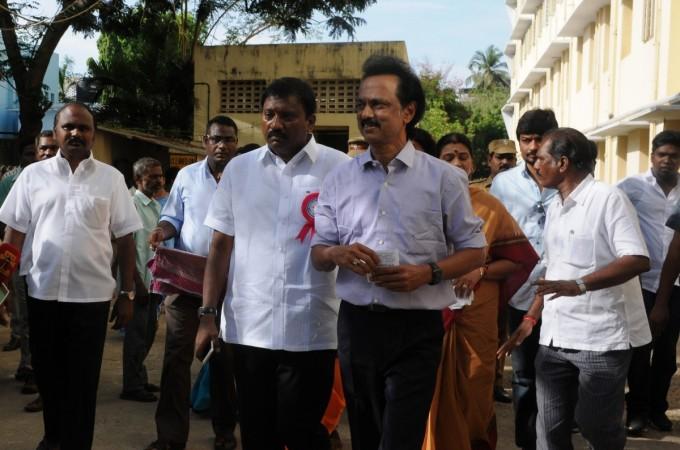
MK Stalin, the working president of the Dravida Munnetra Kazhagam (DMK), was apparently the happiest man in Tamil Nadu this Valentine's Day; he got a gift he would have never imagined. The Supreme Court's verdict convicting V K Sasikala, the chief ministerial aspirant from the rival AIADMK not only sent her to political wilderness for 10 years but also brightened the chances for his party to eye Fort St George, the seat of power in Tamil Nadu. Make no mistake, the virtual heir apparent and CM candidate of the DMK is already eyeing snap polls this June, just 13 months after the May 2016 election results that delivered a defeat for the DMK. The party had ended with 89 seats with the AIADMK securing 134 in the 234-member House.
Addressing party workers in Coimbatore on Wednesday, the 63-year-old politician, who is also the leader of the Opposition in the Tamil Nadu Assembly, said that mid-term polls are likely. In his assessment, whosoever from the rival outfit (AIADMK) becomes chief minister — E Palaniswami from Sasikaka's camp or his rival Panneerselvam — won't stay long, making elections inevitable.
The situation virtually offers the state on a platter to the DMK and Stalin, if they play their cards well along with divine intervention (despite flaunting its atheistic credentials, some leaders of the party do believe in auspicious timings et al, especially while filing nominations).
How does he position himself and his party?
With his strongest rival AIADMK in tatters due to an internecine clash and other parties being fringe players (Congress, PMK), Stalin's DMK has an edge over all others and poised well to breast the tape in the election race.
His job will be made easier if the two camps in the AIADMK — Sasikala and O Panneerselvam — play spoilsport to decimate each other's strength, which could be a possibility if the current bitterness stays for a long time. A patch-up between them is unlikely, notwithstanding the Amma glue that kept them together for about 10 weeks after Jayalalithaa's demise on December 5, 2016.
Given these circumstances, will be offer good governance as an election plank to voters, presuming the political instability forces a mid-term poll? Going a step further, should he seize the opportunity to rise above clichéd positions on Cauvery river water sharing, regional pride and linguistic chauvinism to emerge as a leader who offers a model focussed on economic development and effective administration sans corruption?
The stakes are high and so is the opportunity to emerge as a leader who sheds the traditional DMK baggage and embark on politics that shuns realpolitik. Further, the ideological divide with the BJP notwithstanding, Stalin can also have a policy of tactical understanding with the Central government to expedite projects that need the cooperation of Delhi. The party is of course, no stranger to such arrangements, have aligned with the BJP-led NDA and Congress-UPA and exited the alliances when it deemed fit.
The state will also be on the radar of India Inc., given that it is home to many global and Indian automobile companies, apart from marquee IT companies such as Cognizant Technology Solutions, Accenture, Infosys, TCS and Wipro having their development centres in Chennai or its outskirts. Commercial vehicle maker Ashok Leyland, Royal Enfield-motorcycle maker Eicher Motors, car companies Renault, Ford and Hyundai all have their manufacturing facilities on the outskirts of the state's capital, making it a automobile hub next only to Gurugram (Gurgaon).
The state was the third-biggest contributor (8.16 percent) to India's GDP in 2014-15, after Maharashtra and Uttar Pradesh, according to the government of India. The fourth-largest Indian state's GDP (GSDP) was $175.33 billion in 2015-16 and the per capita GSDP $2,430.5 (at current prices), according to an update by India Brand Equity Foundation. Tamil Nadu has three major ports, 23 minor ports, and seven airports, besides a sprawling rail and road network, making it an ideal destination for manufacturers and exporters.
Tamil Nadu is in a state of limbo for the past few months, starting with Jayalithaa's hospitalisation in September last year, followed by her death 75 days later on December 5 and the resultant chaos within the AIADMK that has brought administration almost to a standstill.
The question that many in Tamil Nadu would be asking is: Should Stalin seize the moment and will he?











